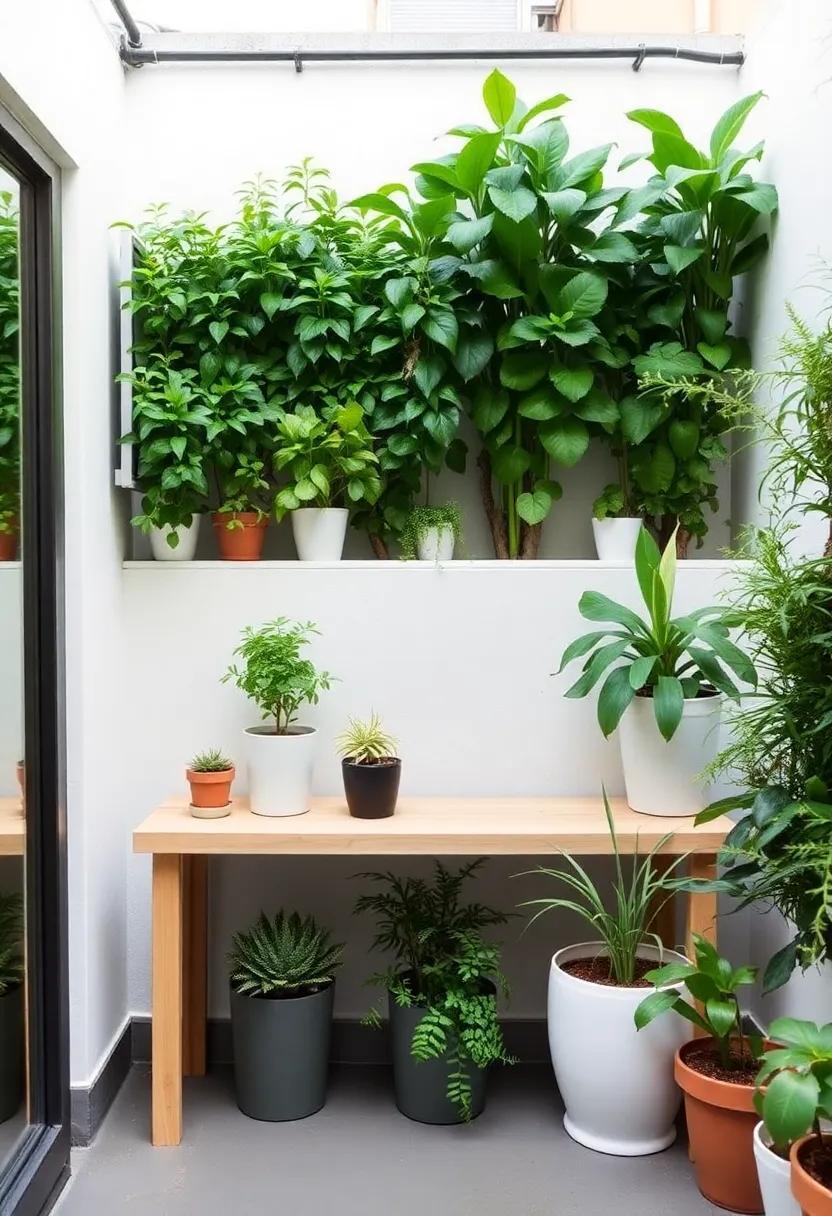
Transforming Tiny Balconies: A Guide to Lush Plant Spaces
Welcome to the world of change, where even the tiniest of balconies can blossom into lush, enchanting plant spaces that uplift your living experience. In urban landscapes,where space is often a rarity,balconies present a unique opportunity to embrace greenery and create a personal oasis. whether you’re an avid gardener or a curious beginner, this guide will walk you through the art of maximizing small outdoor areas, turning them into vibrant sanctuaries filled with life and color. From selecting the right plants that thrive in confined spaces to innovative container gardening techniques that defy the limitations of square footage,join us as we explore the possibilities of creating your own verdant retreat right outside your door. Dive in and discover how to nurture your space—a small balcony may just hold the key to a flourishing garden.
Creating an Oasis: The Benefits of Green Spaces on Tiny Balconies

Imagine stepping out onto your tiny balcony and being greeted by a vibrant explosion of greenery. Green spaces are not just for parks—they can also be the heart of urban living in small apartments. By incorporating a variety of plants,you can create a personal oasis that not only beautifies your outdoor space but also offers numerous psychological and environmental benefits. The presence of plants can lead to improved air quality, promote relaxation, and serve as a soothing escape from the hustle and bustle of city life.With limited space, it’s essential to choose plants that complement each other and thrive in your specific environment.
When designing your balcony garden, consider the following elements to ensure a thriving green retreat:
- Variety of plant Types: Incorporate a mix of flowers, herbs, and small shrubs.
- Mobility: Use pots on wheels to easily rearrange your space as needed.
- Vertical Gardening: Make the most of your vertical space with wall planters and hanging baskets.
- Water Features: A small fountain can enhance the ambiance with soothing sounds.
Here’s a quick look at some plants that work well on balconies and their benefits:
| Plant | Benefits |
|---|---|
| Lavender | Lovely scent, attracts pollinators |
| Snake Plant | Improves air quality, low maintenance |
| Thyme | Edible, drought-resistant |
| Petunias | Vibrant blooms, variety of colors |
By embracing the art of balcony gardening, you can create a lush retreat that not only enhances your living area but also contributes to your well-being. Resources like Audubon offer insights on creating lasting and ecologically friendly green spaces that benefit both you and the environment.
Selecting the Right Plants: Best Choices for Small Outdoor Spaces

When it comes to maximizing the charm of small outdoor spaces, choosing the right plants is vital.consider options that are compact yet visually impactful. Herbs like basil,mint,and thyme not only flourish in pots but also serve a functional purpose in your kitchen. Additionally, ornamental grasses, such as blue fescue or dwarf pampas, create texture and movement without overwhelming the space. For a splash of color, opt for flowering plants like petunias or geraniums; they can thrive in containers and bring life to any balcony or patio.
Another key aspect is selecting plants that complement each other in terms of light requirements and growth patterns.Create a layered effect with trailing plants like ivy or sweet potato vine cascading over the edges of your pots. pair these with upright varieties such as dwarf sunflowers or zinnias for a delightful contrast. Always consider your space’s sunlight exposure—plants like succulents are perfect for sunny nooks, while ferns and shade-loving plants work wonders in dimmer areas. For more inspiration on plant selection and care, check out rhs.org.uk.
Maximizing Vertical Space: Innovative Solutions for Plant Stacking

When dealing with limited balcony space, utilizing vertical arrangements for your beloved greenery is essential. tiered plant stands are a popular choice, offering multiple levels for showcasing an array of plants without occupying too much floor space. You can also consider hanging planters, which not only draw the eye upward but also provide a unique backdrop for your outdoor retreat.Additionally, wall-mounted shelves can serve as an aesthetic display while maximizing space efficiency. To ensure your plants get the required sunlight, mount the shelves on a south-facing wall or about window frames where they can thrive.
Another innovative idea is to create a vertical garden on a trellis for climbing plants like peas or beans. This approach not only saves ground space but also adds an element of greenery that softens hard surfaces. Recycled pallets can be repurposed as a vertical planting structure, offering a rustic charm to your balcony. don’t forget about window boxes; they can be affixed to the balcony railing to enhance your plant collection without crowding your limited area. For more inspiration on vertical gardening techniques, visit Gardena for expert advice and stylish solutions.
Choosing Ideal Pots: Material and Size Considerations for Balcony Gardens

When selecting pots for your balcony garden, the material is a crucial factor that can greatly influence both aesthetics and functionality. Consider the following options:
- Clay or Terracotta: These materials are porously breathable, helping prevent root rot while adding a rustic charm to your garden.
- Ceramic: With their myriad of colors and designs, ceramic pots can be a striking addition, though they might require more drainage modifications.
- Plastic: Lightweight and durable, plastic pots are excellent for moving plants around, though ensure they’re UV-resistant to withstand the elements.
- Metal: Galvanized steel or copper can bring an industrial vibe; though, they can heat up quickly in direct sunlight, possibly harming plant roots.
Size is equally notable. The dimensions of your pots should correspond not only to the types of plants you wish to cultivate but also to your available space. A helpful approach is to review a table of pot sizes along with common plants and their requirements:
| Pot Size | Best For |
|---|---|
| 6-8 inches | Herbs (like basil and parsley) |
| 10-12 inches | Small flowering plants (like pansies or marigolds) |
| 14-16 inches | Medium shrubs (like lavender or rosemary) |
| 18 inches or larger | Small trees (like dwarf citrus) |
Ensure ample room for growth while considering the weight of the pots; heavier materials may take up more physical space without providing additional agricultural benefits. For further guidance on pot selection, check out gardeningknowhow.com.
Colorful Combinations: Harmonizing Plant Colors for Visual Appeal

When designing your balcony garden,the interplay of colors among various plants can create a tapestry that captivates the senses. Choosing vibrant blooms alongside lush greens can enhance the visual impact of your limited space. Consider pairing bold hues, such as the rich purples of petunias or the fiery reds of geraniums, with softer, pastel colors like mint and lavender. This contrast not only brings depth but also helps each color pop against the backdrop of different shades. Create a layered effect by varying plant heights and textures to further enrich the visual appeal of your balcony.
to make informed choices in color combinations, you can follow some simple guidelines that will ensure harmony in your arrangement. Here are a few suggestions to keep in mind:
- Complementary colors: Match opposite colors on the color wheel,like orange and blue,for a vibrant contrast.
- Analogous colors: For a more soothing effect, choose colors next to each other on the wheel, such as yellow, yellow-green, and green.
- Textural contrast: Mix plants with differing leaf shapes and sizes to create dynamic combinations.
Here is a simple table to visualize some effective color pairing for balcony plants:
| Primary Color | complementary Pair |
|---|---|
| Red | White Petunias |
| Yellow | Purple Verbena |
| Pink | Green Ferns |
| Blue | Yellow Marigolds |
By utilizing these strategies,you can craft an enchanting,eye-catching balcony garden that not only thrives but also becomes a stunning visual escape. Explore further ideas and inspirations for plant combinations on Better Homes & Gardens.
Utilizing Edibles: Incorporating Vegetables and Herbs in Limited Space

Making the most out of limited space requires a strategic approach to growing edible plants. By choosing compact varieties of vegetables and herbs,you can create a verdant oasis right on your balcony. Vertical gardening techniques can also maximize your space: consider using wall planters or cascading pots that allow herbs like basil, parsley, and chives to flourish upward rather of outward. Additionally, you might explore container gardening with pots that can easily fit into nooks or along rails. Select a mix of sun and shade-loving plants to provide variety,allowing you to experiment with flavors and culinary applications.
Utilizing companion planting can enhance both growth and flavor. Planting tomatoes alongside basil can not only save space but also boost the taste of your dishes. Herbs like oregano and thyme can intermingle with leafy greens, creating a vibrant tapestry of flavors while making the most of your balcony’s greenery. For those seeking a bit of structure, consider arranging your plants in a simple grid layout: a combination of high-growing plants like peppers alongside low-spreading greens can create a visually stunning and functional garden. For more insights into urban gardening techniques, check out Urban Harvest.
Fostering Wildlife: Attracting Birds and Butterflies to Your balcony

In addition to selecting the right flora, integrate bird feeders and butterfly baths to make your balcony even more appealing. Consider adding a small table or a hanging accessory where birds can perch safely. Use organic,chemical-free seeds to ensure you’re helping,not harming,the wildlife. For butterflies, a shallow tray filled with water and stones will provide a perfect spot to sip and bask. Remember to keep your plants fresh and water them regularly to maintain an oasis. For more detailed tips on gardening and wildlife attraction, visit Gardeners.
Seasonal Planting: How to Rotate Your Balcony Garden Year-Round

To facilitate a smooth transition between seasonal crops, implement a simple rotation plan tailored to your balcony’s specific conditions. A helpful guideline can be organized in a table format:
| Season | Suggested Plants | Maintenance Tips |
|---|---|---|
| Spring | Petunias, Snapdragons, Lettuce | Ensure proper drainage and moderate watering. |
| Summer | Tomatoes, Zinnias, Basil | Regularly check for pests and provide support for climbing plants. |
| Autumn | Kale, Pansies, Garlic | Mulch to retain moisture and protect roots from frost. |
| Winter | Evergreens, Winter Jasmine | Limit watering and ensure adequate sunlight exposure. |
With careful planning and a little creativity, your balcony can continuously yield beauty and edibles throughout the year. For tips and resources on plant choices, visit americanhort, where you can find guidance tailored to your gardening aspirations.
Creating Shade: Using Canopies and Trellises for Sun Protection

In the quest to cultivate a thriving mini jungle on your balcony, canopies and trellises emerge as essential elements for crafting a shaded oasis. These structures not only provide relief from the harsh sun but also elevate the aesthetics of your space. When selecting a canopy,opt for materials that are both durable and sun-resistant; fabric options such as canvas or outdoor-rated polyester are perfect for this purpose. Moreover, consider adjustable canopies that can easily be drawn back during cooler evenings or rainy days, allowing you to enjoy varying degrees of sunlight. Pair your canopy with a trellis that supports climbing plants,creating a vertical garden that pulls the eye upward and maximizes your limited space.
When it comes to trellises, the options are abundant and dynamic. Wooden, metal, or even PVC structures can be adorned with a variety of vining plants that not only provide shade but also offer lush greenery and delightful fragrances. Here’s a quick reference for some ideal climbing plants to grow on your trellis:
| Plant type | Light Requirement | Growth Rate |
|---|---|---|
| Sweet Peas | Full sun | Fast |
| Morning Glory | Full sun | Fast |
| Clematis | Partial shade | Moderate |
Integrating these elements into your balcony not only enhances its functionality but also transforms it into a serene retreat.For additional insights and inspiration on creative balcony designs and plant pairings, visit Houzz.
Decorative Elements: Enhancing Your Balcony With Stylish Planters

Moreover, don’t shy away from opting for unique designs. Geometric planters, for instance, can provide a modern flair, while vintage-style pots can impart a charming, rustic vibe. To enhance your overall design, think about adding sustainable options, such as self-watering planters, which not only look great but also simplify your gardening routine. Incorporating greenery can transform your balcony into a lush oasis, and resources like The Spruce offer a treasure trove of inspiration and tips to style your outdoor sanctuary effectively. Your balcony can become a vibrant escape, full of life and color, simply through the thoughtful selection of planters.
Lighting Your Garden: Creative Outdoor Lighting Ideas for Ambiance

Creating an enchanting atmosphere on your balcony can be as simple as incorporating clever lighting choices. String lights are a timeless favorite; drape them above your seating area or around railings for a soft, twinkling glow. Lanterns, whether they are tabletop or hanging, can serve as attractive focal points. For a magical touch, consider using solar-powered fairy lights nestled among your plants—they not only serve as eco-friendly illumination but also highlight your green oasis as dusk falls. Don’t forget to mix up your lighting heights for added dimension and interest!
For those looking for a more polished finish, ground-level pathway lighting can guide guests to your cozy gathering space while accentuating the beauty of your plants. Outdoor wall sconces can provide steady,functional lighting that frames your balcony beautifully. For an avant-garde twist, incorporate projected light patterns on walls or surfaces, giving an artistic edge to your space. Pair these lighting ideas with various plant heights and textures, and you’ll cultivate a serene haven that’s perfect for evenings spent outdoors. explore more creative techniques at Gardenista.
Innovative Irrigation: Simple Systems to Keep Plants Hydrated

Creating an efficient watering system can transform how you maintain your balcony garden. Embrace drip irrigation, which allows water to seep directly into the soil at a slow rate. This not only reduces waste but ensures that each plant receives consistent hydration. another option is a self-watering planter that utilizes a reservoir at the base, providing a steady supply of moisture while minimizing the frequency of manual watering. Pairing these systems with moisture sensors can further automate the process, alerting you when attention is needed or, if connected to a simple irrigation system, allowing it to operate automatically.
Consider adding a rainwater collection system to your balcony. These systems can harvest rainwater from roof runoff, making your gardening efforts more sustainable and eco-friendly. Additionally, using materials such as capillary matting can provide a simple solution for keeping plants consistently moist. Lastly,organizing your plants by their water needs will ensure that each species thrives,with less risk of over- or under-watering. for detailed guides on setting up these innovations, visit gardeningknowhow.com for expert advice and inspiration.
Personalized Decor: Adding Unique Touches to Reflect Your Style

Creating a cozy oasis on your tiny balcony entails selecting decor that mirrors your personality while harmonizing with the natural elements. Choose planters that are not only functional but also artistic, like hand-painted ceramic pots or vintage metal containers.Incorporate string lights to create a magical atmosphere during the evenings, and don’t forget about textiles—a colorful outdoor rug or soft cushions on stools can elevate the space significantly. Personal touches could include hanging framed photographs or incorporating other memorabilia that tells your story.
To harness a truly customized feel, consider integrating elements that evoke your preferred aesthetic. You might opt for a minimalistic vibe with sleek, monochrome planters or lean into a bohemian style with macrame hangers and a mix of patterned textiles. To further personalize your balcony, create themed zones such as a reading nook with a small bookshelf or a vibrant aromatherapy corner featuring scented plants like lavender and basil. remember, every detail counts, so take the time to curate a unique atmosphere that aligns with your style and invites tranquility. For more inspiration, visit houzz.
Safety First: Ensuring a Secure Environment for Elevated Gardens
Creating a vibrant elevated garden can be a joyous endeavor, but it’s crucial to prioritize safety in the process. Whether you’re working with a small balcony or a rooftop space, ensuring that your plant setup is secure can prevent accidents and damage. Start by assessing your balcony’s structural integrity.Make sure the railing is stable, as well as the weight-bearing capacity of your balcony, especially if you’re planning to incorporate heavy planters or multiple layers in your design. Additionally, consider using lightweight materials for pots and planters, which help reduce the risk of overloading the space.
Furthermore, organizing your gardening tools and supplies is essential for maintaining a safe environment. Keep the area free of clutter, using designated storage solutions to house your soil bags, tools, and pots. It’s also wise to implement a secure watering system; consider drip irrigation to minimize spills and reduce slip hazards. Establish safety protocols, such as using a non-slip mat under your pots and avoiding overreaching when tending to your plants. For more extensive guidelines on safe gardening practices, you can explore resources available on gardeningknowhow.com.
Eco-Friendly Choices: Sustainable Practices for Balcony Gardening

Creating a balcony garden not only brings joy and color to your living space but can also embody eco-friendly principles that contribute positively to our environment. Start by selecting native plants that are well-adapted to your local climate, as they require less water and are less prone to pests. Use upcycled materials for planters, such as old wooden crates, tin cans, or even fabric pots made from old textiles. These practices reduce waste and create a unique aesthetic. Additionally, consider implementing a composting system for kitchen scraps, which can provide nutrient-rich fodder for your plants while minimizing landfill contributions.
Water management is another effective way to practice sustainability in balcony gardening. Opt for drip irrigation systems or self-watering planters that conserve water and ensure your plants receive consistent moisture. Furthermore, utilize rainwater collection techniques, like installing a small rain barrel, to nourish your greenery. Pair these methods with organic fertilizers to maintain soil health without the harmful effects of synthetic chemicals. Don’t forget to add biodiversity with pollinator-friendly flowers that attract bees and butterflies, turning your small space into a vibrant ecosystem. For tips on sustainable gardening practices, visit ornamentalgardens.com.
Exploring Themes: Designing Your Balcony Around a central idea

- Rustic Charm: Incorporate weathered wood furniture and natural fibers, complemented by herbs and wildflowers.
- Modern Minimalism: Choose sleek lines and monochromatic colors,opting for succulents or air plants to maintain clean aesthetics.
- Tropical Paradise: Fill your space with lush greenery and colorful blooms, accentuated by bamboo or rattan furnishings.
Once you’ve settled on a theme, maximize the impact of your chosen design with smart plant selection and layout. Using vertical gardens, hanging planters, or tiered shelving can add depth while maintaining accessibility. Consider the following table for plant ideas that align with different themes:
| theme | Recommended Plants |
|---|---|
| Rustic Charm | Rosemary, Lavender, Marigolds |
| Modern Minimalism | Snake Plant, ZZ Plant, Cacti |
| Tropical Paradise | Pothos, Hibiscus, Bird of Paradise |
By harmonizing your plant choices with the overall design theme, your balcony can transform into a lush, personalized escape. For more insights on balcony gardening, visit Gardenista.
Bringing Nature Indoors: Connecting Balcony Plants with Indoor Spaces

Integrating outdoor greenery with your indoor atmosphere can create a harmonious living space that feels both refreshing and serene. One effective method is to select complementary plant types that thrive in both environments. As a notable example,consider using potted herbs like basil or mint,which not only add a splash of green but also provide a delightful aroma in the kitchen.Incorporating hanging planters will optimize your vertical space and give the illusion of flowing greenery. These plants create a seamless transition between your balcony and home, inviting nature into your daily routine.
When you’re ready to elevate your plant game, consider arranging your balcony plants to draw the eye indoors. A few key tips to achieve this include:
- Choose plants with similar color palettes: Pair vibrant balcony flowers with neutral indoor pots.
- Replicate textures: Use a mix of smooth, soft, and spiky plants in your arrangements.
- Create a visual pathway: Position tall plants near windows to guide the view inside.
By selecting the right plant combinations and crafting thoughtful arrangements, you foster an inviting atmosphere that blurs the boundaries between your indoor and outdoor spaces. For more inspiration, check out resources from Gardening Know How.
Showcasing Seasonal Blooms: Planning for Year-Round Flowering Displays

To create a dazzling balcony garden that enchants throughout the year, strategic planning is essential. Begin by incorporating flowers that bloom in different seasons to ensure that your balcony is always adorned with vibrant colors. Consider including early spring contenders like pansies and daffodils, which can thrive even in cooler temperatures, followed by summer favorites such as petunias and geraniums that bring life and fragrance. As autumn approaches, swap in chrysanthemums and ornamental kale to keep your display lively, and in the winter, evergreen plants or seasonal winter pansies can maintain greenery and splash of color.
To make selecting and caring for your plants easier, consider grouping them by their light and water requirements. This way, you can create a harmonious balance in your tiny oasis. Employ vertical gardening techniques to maximize space, utilizing trellises or shelves to showcase your blooms. Don’t forget to incorporate herbs, which not only serve as splendid companions but also provide practical benefits. Here is a quick reference table to facilitate your seasonal selection:
| Season | Flowers | Notes |
|---|---|---|
| Spring | Pansies, Daffodils | Cold-resistant, cheerful blooms |
| Summer | Petunias, Geraniums | Rich colors, drought-tolerant |
| Autumn | Chrysanthemums, Ornamental Kale | Fall colors, hardy |
| Winter | Evergreens, Winter Pansies | Year-round greenery |
Incorporating a variety of blooms not only enhances aesthetic appeal but also attracts beneficial pollinators. Create a little micro-ecosystem by researching and planting flowers that will attract bees and butterflies. For more detailed inspiration on seasonal plants and their care, visit bhg.com.
Final Thoughts
As we draw the curtains on this exploration of transforming tiny balconies into luscious plant spaces, we hope you feel inspired to take that first step into your own green oasis. Remember, even the smallest of spaces can blossom with creativity and nature, offering you a peaceful retreat amidst the hustle and bustle of daily life. Whether you choose vibrant flowers, aromatic herbs, or lush foliage, the key lies in thoughtful planning and a touch of personal flair.
So grab your pots and soil, and let your inventiveness take flight. Each balcony is a blank canvas waiting for your unique touch, and we can’t wait to see how you bring yours to life. Happy gardening!
As an Amazon Associate I earn from qualifying purchases.



